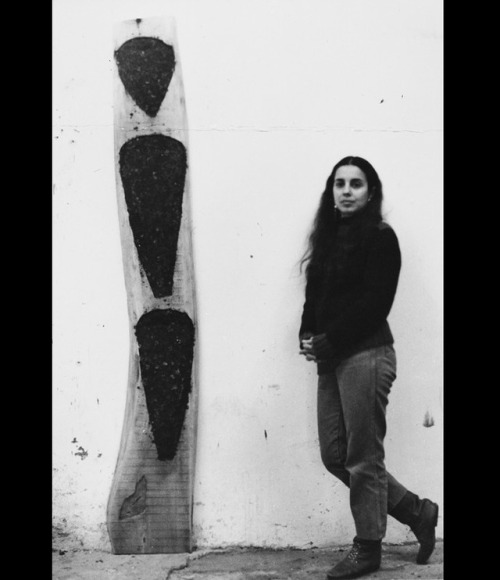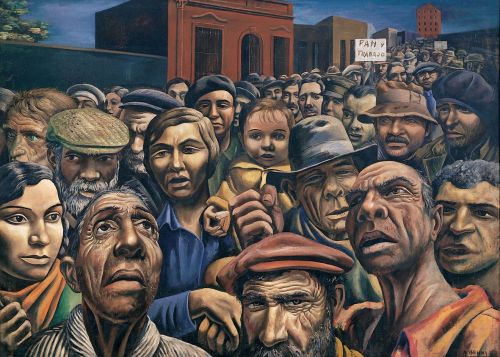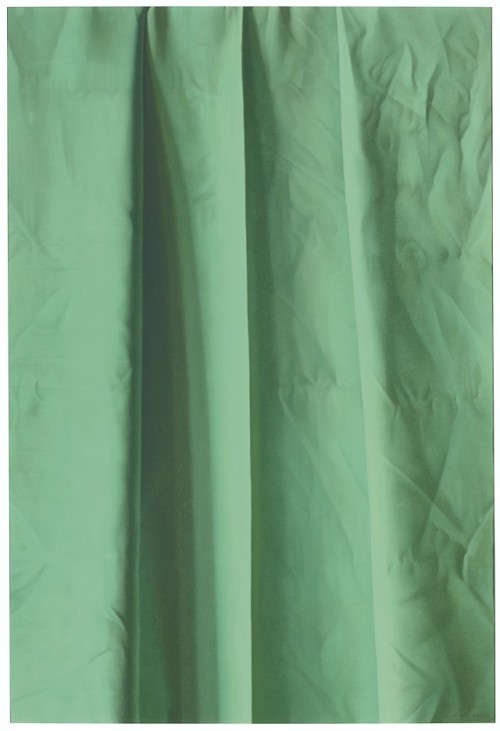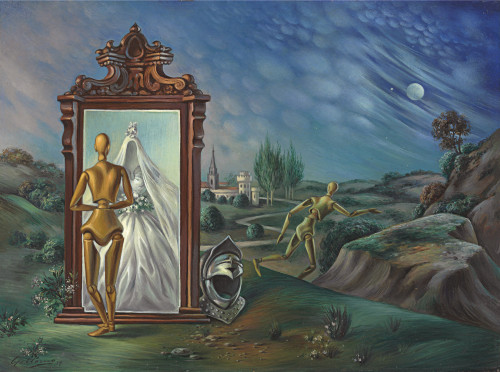#latin american art

#repost @mauroagustincruz Mauro Agustin Cruz (Argentina, 1991-). Prudencia, oil on cloth, 60 x 70 cm, 2021. Note the representation of a black cat.
Anonymous,Last Supper(La Última Cena), polychrome clay, Ocumicho, Michoacán Collection, Centro Cultural Tijuana
Post link
Demonstration (Manifestación)by Antonio Berni (1905 - 1981, Argentina), 1934,
Temple on arpillera (burlap), 180 x 249,5 cm, Latin American Art Museum of Buenos Aires.
Post link

CALL TO ARTISTS
ColabCollage
Deadline: Tuesday, 10 May 2022 (residents of Europe only). Brazilian-Swiss collagist Ana Barros’ idea for World Collage Day 2022 is to create together! Ana will start a collage on an A6 sheet (148x105mm) and mail it to the participants to finish it. Participants have until Tuesday, 10 May 2022 to complete it and send her a photo (or scanned image). Ana will put all the artworks together and prepare a video with them to celebrate World Collage Day. For logistical reasons, Ana can only mail starter collages to residents of Europe. A digital starter collage will be made available for non-Europeans to take part. MORE
*****************************
Kolaj Magazine, a full color, print magazine, exists to show how the world of collage is rich, layered, and thick with complexity. By remixing history and culture, collage artists forge new thinking. To understand collage is to reshape one’s thinking of art history and redefine the canon of visual culture that informs the present.

WORLD COLLAGE DAY - LAKE FOREST PARK, WASHINGTON, USA
World Collage Day at ShoreLake Arts Gallery
14 May 2022, Noon-3PM PDT | Shorelake Arts Gallery | 17171 Bothell Way NE. Bring your scissors and join Andrea Lewicki, The Sewing Collage Artist, for a collaborative collage party celebrating World Collage Day! Together we will collage flowers that will later be sewn together to create a community garden mural. Glue sticks and paper will be available as long as supplies last. You are welcome to bring a magazine or collage materials to share. Lewicki will provide examples and templates. No previous collage experience is needed to participate in this free event! MORE
*****************************
World Collage Day is May 14th, 2022.
World Collage Day is an annual, international celebration of collage on the Second Saturday of May. Initiated by Kolaj Magazine in 2018, we invited artists and art venues to hold events on that day to celebrate collage. On the event website, you can download a free poster, order a copy of the World Collage Day Special Edition, and see events from around the world.
EVENT WEBSITE

FROM THE ARTIST DIRECTORY
Joyful, Whimsical & Dark
Winscombe, North Somerset, United Kingdom. Ros Cuthbert embraces joyful, whimsical and dark imagery. Musical, theatrical, ecological, socio-political and personal themes permeate her work. Cuthbert has worked with a variety of materials and for the past few years has explored collage with paint and graphic media. The colored or printed pieces offer a visual conversation between design and meaning which can allow the image to develop in surprising ways. MORE
*****************************
Kolaj Magazine, a full color, print magazine, exists to show how the world of collage is rich, layered, and thick with complexity. By remixing history and culture, collage artists forge new thinking. To understand collage is to reshape one’s thinking of art history and redefine the canon of visual culture that informs the present.

WORLD COLLAGE DAY - SAN FRANCISCO, CALIFORNIA, USA
CUTTING EDGE Collage-a-Rama Exhibition Artist Talk on-line via Zoom
14 May 2022, 11AM PDT | Arc Gallery, online via Zoom | 1246 Folsom Street
Celebrate the art of collage with San Francisco artists during the “CUTTING EDGE” World Collage Day Artist Talk in conjunction with the "CUTTING EDGE" Collage-a-Rama Exhibition in the Project Gallery at Arc. All of the work was made during collage-making sessions at Arc Gallery. Featured artists include Carrington Arredondo, Glenn Bachmann, Johnny Botts, Dianne Hoffman, Priscilla Otani, Barbara Pollak-Lewis, Steve Sweetser, Stephen C. Wagner, and Tanya Wilkinson. The exhibition runs 9 April-7 May 2022 with an opening reception Saturday, 9 April, 7-9PM. Register in advance for the Artist Talk on Zoom. MORE
*****************************
World Collage Day is May 14th, 2022.
World Collage Day is an annual, international celebration of collage on the Second Saturday of May. Initiated by Kolaj Magazine in 2018, we invited artists and art venues to hold events on that day to celebrate collage. On the event website, you can download a free poster, order a copy of the World Collage Day Special Edition, and see events from around the world.
EVENT WEBSITE

COLLAGE ON VIEW
Corporeal Gestures
at the Portland State University School of Architecture in Portland, Oregon, USA through 29 April 2022. In 2019, collage artist Clive Knights put out an international call for submissions from collage artists, asking them to respond to nine “muses”, characterized as the bodily necessities of breathing, nourishing, sleeping, discharging waste, procreating, resisting the earth’s pull, communicating, aging and dying. The result is an exhibition of work by more than 100 collage artists from twenty-one countries. The work presents a diverse response to the ways in which our actions, rhythms, relationships and shared experience of being alive are both predetermined and made possible by the modicum of matter borrowed from the world that constitutes each of our bodies. The project challenged collage artists to consider how one’s body is activated in the world–acting, gesturing, making–amidst the shared rhythms pertaining to our common, mortal predicament in a single, unfolding cosmos. MORE
*****************************
Kolaj Magazine, a full color, print magazine, exists to show how the world of collage is rich, layered, and thick with complexity. By remixing history and culture, collage artists forge new thinking. To understand collage is to reshape one’s thinking of art history and redefine the canon of visual culture that informs the present.

WORLD COLLAGE DAY - FANØ, DENMARK
World Collage Day Exhibition
14 May-7 June 2022 | Fanø Plejecenter | Sønder Engvej 2. Between 15-20 amateur collage artists will have work on display for this exhibition. The call for artists asked for collage work from artists that had never shown in an exhibition before, giving an opportunity for those that are just beginning their collage journey. Located in the garden of the Care Center, there will be music and drinks. All are welcome. MORE
*****************************
World Collage Day is May 14th, 2022.
World Collage Day is an annual, international celebration of collage on the Second Saturday of May. Initiated by Kolaj Magazine in 2018, we invited artists and art venues to hold events on that day to celebrate collage. On the event website, you can download a free poster, order a copy of the World Collage Day Special Edition, and see events from around the world.
EVENT WEBSITE

COLLAGE ON VIEW
The Art of Jean LaMarr
at the Nevada Museum of Art through 29 May 2022. “The Art of Jean LaMarr” is a major retrospective of the work of one the most influential Native American artists practicing today. The exhibition presents more than 100 paintings, prints, and sculptures spanning five decades of the art and activism of Jean LaMarr (b. 1945), whose melding of post-modern eclecticism and Native American motifs and subject matter has affirmed the dignity of Native American women, addressed the legacy of colonialism, and above all sounded a ringing “rejection of the idea of the vanished American Indian.” MORE
*****************************
Kolaj Magazine, a full color, print magazine, exists to show how the world of collage is rich, layered, and thick with complexity. By remixing history and culture, collage artists forge new thinking. To understand collage is to reshape one’s thinking of art history and redefine the canon of visual culture that informs the present.

WORLD COLLAGE DAY - BOLOGNA, ITALY
Collazine: Artists at Risk Fundraiser
14 May 2022 | Collazine | Online. Wars, pandemics, climate change. The world seems to be an unsafe place to live in today and when we think that the only refuge may be in a better future, we realize that we are already living it, and should navigate it with care. It’s not possible to erase the past, but let’s imagine we have a blank sheet ready to rewrite a new story lived by moments of quiet, optimism and trust. We imagine a different future, but one so close that it can almost be touched. On the occasion of World Collage Day, Collazine will launch a fundraiser in support of Artists at Risk, a non-profit organization that since 2013 has been assisting artists who are politically vulnerable and are fleeing oppression and war in 26 locations, in 19 countries around the world. Artists at Risk hosts persecuted artists, writers, curators, critics and scholars by facilitating their safe passage from their countries of origin, hosting them at Artists at Risk Residencies and curating related projects. On rapso.org, unpublished collages made by ten international artists, inspired by the theme, a prompt to create a candid space in pursuit of a different future, will be made available for purchase. All proceeds will be donated to Artists at Risk. MORE
*****************************
World Collage Day is May 14th, 2022.
World Collage Day is an annual, international celebration of collage on the Second Saturday of May. Initiated by Kolaj Magazine in 2018, we invited artists and art venues to hold events on that day to celebrate collage. On the event website, you can download a free poster, order a copy of the World Collage Day Special Edition, and see events from around the world.
EVENT WEBSITE

FROM THE ARTIST DIRECTORY
Reveal What’s Beneath
Brooklyn, New York, USA. Meghan Larimer’s collages are her visual diary, interpretations of thoughts and observations, therapy for her wild range of feelings, and a visualization of the poetic narrative in her head. They vary from whimsical to violent, dreamy and surreal. Inspired by the unintentional collage of New York and other cities, Larimer writes, “The street art and walls tell a story of the transient art that is constantly changing with every tag, poster, and attempt to cover it all up with a fresh coat of paint, only to be peeled away to reveal what’s beneath. I try to replicate this beautiful process in my work.” MORE
*****************************
Kolaj Magazine, a full color, print magazine, exists to show how the world of collage is rich, layered, and thick with complexity. By remixing history and culture, collage artists forge new thinking. To understand collage is to reshape one’s thinking of art history and redefine the canon of visual culture that informs the present.

WORLD COLLAGE DAY - MEXICO CITY, MEXICO
Hello Collage
14 May 2022, Noon-5PM CDT | Palacio de Minería | Calle de Tacuba 5, Centro Histórico de la Ciudad de México. Artifício Postal, the community-facing, workshop-oriented collage practice of Selene Ramírez, is celebrating the ability to meet again on this year’s World Collage Day. Ramírez invites you to join her for a community experience centered around collage. Three events will take place throughout the day. The first event is a collage workshop from Noon-1:30PM. The second event is a meet-up from 2-5PM where artists and enthusiasts can discuss collage and get to know each other. The culminating event is a forum from 3-4PM where the public can get to know the people who are making collage in Mexico City. Each event takes place within the Palacio de Minería, a beautiful historical building located in the center of the city. All events are free and open to the public, however the first two events require registration. To register, send an email to [email protected]. MORE
*****************************
World Collage Day is May 14th, 2022.
World Collage Day is an annual, international celebration of collage on the Second Saturday of May. Initiated by Kolaj Magazine in 2018, we invited artists and art venues to hold events on that day to celebrate collage. On the event website, you can download a free poster, order a copy of the World Collage Day Special Edition, and see events from around the world.
EVENT WEBSITE

COLLAGE RESIDENCY
Poetry & Collage Residency – Round 2
After learning a lot from March’s artists, Kolaj Institute heads back in for another round and we’re excited to announce the next twelve artists selected to participate in the Poetry & Collage Residency. Throughout April, through discussion and collaboration, the participating artists and writers will investigate what is at the intersection of collage and poetry. Their efforts will result in a publication of the work they’ve made throughout the month. MORE
*****************************
Kolaj Magazine, a full color, print magazine, exists to show how the world of collage is rich, layered, and thick with complexity. By remixing history and culture, collage artists forge new thinking. To understand collage is to reshape one’s thinking of art history and redefine the canon of visual culture that informs the present.

WORLD COLLAGE DAY - SYDNEY, AUSTRALIA
Belles Lettres: Collage in the Age of Covid Exhibition
12-22 May 2022 | Scratch Art Space | 67 Sydenham Road
A group of 10 Sydney-based collage students are showing their work with an exhibition opening on World Collage Day. During the Covid pandemic, Australia closed its borders and experienced one of the harshest lockdowns in the world. During this unique and uncertain time, students of the WEA, Sydney (Workers Educational Association, est. 1913.) were delivered a wonderful online weekly collage class by visual arts teacher, Brendan Vivian Smith. Over these weeks of stay-at-home orders the group created collage with images, materials, and papers that were at hand. The class also provided structure to the week and vital social connection. Collectively the group created new horizons, stories, and imaginings that brought beauty into their lives and kept their world large. This exhibition celebrates that work. MORE
*****************************
World Collage Day is May 14th, 2022.
World Collage Day is an annual, international celebration of collage on the Second Saturday of May. Initiated by Kolaj Magazine in 2018, we invited artists and art venues to hold events on that day to celebrate collage. On the event website, you can download a free poster, order a copy of the World Collage Day Special Edition, and see events from around the world.
EVENT WEBSITE

CALL TO ARTISTS
Create for Ukraine
Sunday, 24 April 2022, 9AM EDT/3PM CEST. Art Therapist Julia Volonts facilitates a three-hour art therapy workshop on Zoom using collage for social action to provide community support, raise funds and further awareness on the war in Ukraine. Donation Fee to Participate: $25 USD. All proceeds will go to the Kyiv Collage Collective. MORE
*****************************
Kolaj Magazine, a full color, print magazine, exists to show how the world of collage is rich, layered, and thick with complexity. By remixing history and culture, collage artists forge new thinking. To understand collage is to reshape one’s thinking of art history and redefine the canon of visual culture that informs the present.
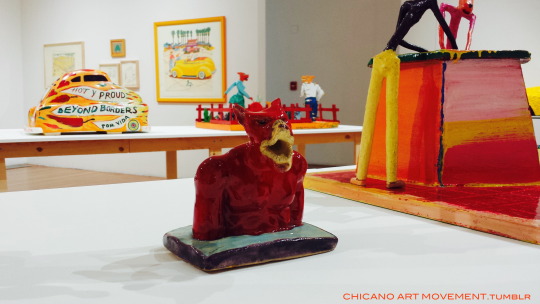
(Detail: gallery view of “Aztlán to Magulandia: The Journey of Chicano Artist Gilbert “Magu” Luján” at the University Art Galleries.)
CAM:
For our November 2017 PST: LA/LA themed field trip, we visited the University of California, Irvine (UCI) to examine “Aztlán to Magulandia: The Journey of Chicano Artist Gilbert ‘Magu’ Luján.” Researching the exhibition prior to our arrival, I learned from the information provided by university that this was “the first survey of one of the most iconic figures of the Chicano art movement.” UCI had also exhibited the work of Luján’s collective Los Four in 1973. Once on campus, we were educated that the survey was split into two areas: the University Art Gallery (UAG) and the Contemporary Arts Center (CAC) Gallery. We chose to visit the UAG first as our introduction. Inside we were welcomed into the gallery by an assortment of glossy glazed colored ceramic sculptures that were created by the artist throughout his years. Most were located near the entrance, placed on platforms in the center of the gallery for up close analyzation.
Along with Magu’s sculptures inside the UAG, we viewed works on paper from originals to prints with other one of a kind pieces which included many of his well-known anthropomorphic creatures. There we were provided with a “List of Works” pamphlet for the participating galleries and that is when we noticed no museum labels adhere beside the artworks. Initially, Anita and I had attempted to decipher titles of the art with provided pamphlet. Some of the artwork titles we were familiar with from previous viewings showcasing Magu’s work throughout the years. No labels for us fostered moments of contemplation while viewing his many prismatic colored creations adorning the wall spaces.
After spending time inside the UAG surveying the art, we then moved on to the CAC Gallery which was about a two minute walk away. Once inside the gallery what had first grabbed my attention was what appeared to me as an altar installation upon initial glance. Upon further examination, I learned the large three-dimensional artwork was a mixed media piece entitled “Trailing los Antepasados.” Close up the massive piece contained many elements of indigenous images in Mr. Luján’s style which narrated a story of migration. The allotment was a “reformulation of Returning to Aztlán” a serigraph print created by the artist which too was exhibited at “Aztlán to Magulandia” very near the three-dimensional, mixed media artwork.
As we walked through the Contemporary Arts Center Gallery, I had noticed a more fluid curated narration of the artworks displayed in this area. Here were multiple works of art located adjacent to each other combined to chronicle tales of love, indigenismo, and migration through the brightly colored lenses of Mr. Gilbert “Magu” Luján.

(View of “Virgen de Guadalupe, Chalma, México” by Graciela Iturbide for Revolution & Ritual exhibition.)
During the long holiday weekend of November 2017, we made a trip to see three participating institutions of the PST: LA/LA programming. Our first location was the Pomona College Museum of Art located on the campus grounds of the Claremont Colleges (a collective of five undergraduate liberal art colleges in the city of Claremont). This college museum hosted the exhibit “Prometheus 2017: Four Artists from Mexico Revisit Orozco” that highlighted the work by four mujeres: Adela Goldbard, Rita Ponce de León, Naomi Rincón-Gallardo, and Isa Carrillo. After reading the welcoming exhibition mission statement within Pomona College Museum of Art’s entrance area, we proceeded to the lower level to the historical collection of sketches and drafts that reflected Orozco’s planning processes to create such a mural masterpiece that is located inside Frary Dining Hall of Pomona College that was completed in 1930; which we visited in conjunction with our itinerary of PST: LA/LA events.
We continued down the hallway and entered an expansive room that contained the video installation by Adela Goldbard. From the exhibit pamphlet provided by the museum, it explained that Goldbard and the use of fire while burning items in an effigy style were to symbolize the political violence of Mexico; some items that were set a blaze were: vehicle replicas and piñatas of politicos and bulls. The video and audio footage displayed within the museum, and the incorporation of volatile flames by Goldbard is similar to the inferno inclusion by Orozco with his piece “Prometheus” which according to Greek mythology, Prometheus gave fire to the human race that in turn enabled them to have progress and, later, civilizations. Through Goldbard’s video installation and within the context of Mexico, the fire of “Prometheus” has been an antithesis due to the country’s high level of criminal activity that is allowed by the corrupt politicians and police officials and not the civilized society related to the Greek god.
The next section that Robert and I entered was a curated historical timeline of facts, pictures, and ephemera between the connection of Pomona College and the “Prometheus” mural by José Clemente Orozco. After this we crossed into the extensive painting by Rita Ponce de León. Her body of work were the words spoken by Claremont College students who answered the following questions: “What does Prometheus mean to you?” and “What does art mean to you?” Ponce de León transferred these “inherited conversations” (students’ responses to questions) by directly painting them onto the museum walls thus, literally, leaving her mark on the Pomona College campus [similar] in likeness of Orozco’s “Prometheus” mural.
Our path was then guided to the works by Naomi Rincón-Gallardo. Patrons were instructed use the accompanying headphones to fully comprehend the videos that reflected themes of liberation, feminist thought, and the push towards to enlightenment which are pillars of the Greek god Prometheus.
The last mujer featured in this exhibit was Isa Carrillo. The accompanying literature explained Carrillo took direct inspiration from José Clemente Orozco due to her artist residency at his house studio in Guadalajara, Jalisco, México and her work was a direct response to her time there. Isa Carrillo included various pieces inspired by the tragic firework accident in which Orozco lost his left hand. For example one of Carrillo’s pieces was a display of test tubes filled with gunpowder which reflected the same substance that caused the amputation in 1904.
We departed Pomona College and drove to the neighboring campus of Scripps College to visit the second participating institution of the Ruth Chandler Williamson Gallery. This institution of the Claremont Colleges organized the exhibit “Revolution and Ritual: The Photographs of Sara Castrejón, Graciela Iturbide, and Tatiana Parcero.” The accompanying catalogue explained the focus to be of “women who have shaped the photographic field” of Mexico beginning in 1908 to the present and how these mujeres were trailblazers in their own right. This gallery made its presence known that beyond its autumn courtyard was a warm welcome for one to examine these female photographers who all shared a special connection to Mexico. The first woman was to our left, the surrealist photographer, Graciela Iturbide. The exhibit catalogue contained the details behind Iturbide’s subject matter. An essay by Ph.D. Associate Researcher Marta Dahó explained that Graciela Iturbide that photography was used “to preserve the intensity of the encounter characterized by an atmosphere of complexity and surprise” at a specific moment in time and space. This intensity is indeed captured by Graciela Iturbide in “Nuestra Señora de Las Iguanas, Juchitán, Oaxaca” (1979; translation: “Our Lady is the Iguanas, Juchitán, Oaxaca), a figurative portrait of a Mexican woman graciously wearing a crown of live iguanas atop of her dark hair.
We continued along the gallery walls in a clockwise fashion and found the second artist: Tatiana Parcero. This photographer used the medium along with historical imagery to create symbolism and interpretation through the human body. The essay by Dr. Esther Leah Gabara, an Associate Professor of Romance Studies at Duke University, stated that the artist used her own body as the model for all the pieces then layered the historical visual to create a unique interpretation for the patron to look between the lines or in the case of Tatiana Parcero, to look between the layers.
The third women in this exhibition was Sara Castrejón: a native from Teloloapan, Guerrero was born in 1888 to an affluent familia who studied photography in Mexico City at the age of eighteen which was an oddity for women during the early part of the twentieth century. In the center of the gallery, we reached Castrejón’s collection of original photographs as well as information inserts that recreated the harshness of the Mexican Revolution with hint of amazement for these artifacts to have survived this long. Noted research professor from la Universidad de Puebla, John Mraz explained in his essay within the catalogue that Castrejón returned to her hometown, a small city, to work alongside her sister Dorotea to open a photography studio and began to document the life occurrences when Mexico began to change due to the nation’s revolutionary movement. Sara’s decision to stay and be committed to Teloloapan as a resident was at the center of her photographic lens which led her to be “the only women to extensively document the Mexican Revolution (1910-20) [and] one of the earliest female war photographers in the world.” The curated display included different stages of the Mexican Revolution and its countless interactions with the city and residents of Teloloapan: from various revolutionary factions taking control of the township and the immortalization of military generals to documenting the lesser known sides of the rebellion - female participants, war effects on children, and the precious moments of life before execution.
To close our PST: LA/LA trip to the Inland Empire, we departed the Claremont Colleges and drove to downtown Pomona, just a few miles away. The third and final location was the dA Center for the Artswith“d’Aztlán: A Sense of Place”an exhibit that explored “the Chicano/a art movement and the vast influences that Chicano/a culture has had on the southwestern United States and beyond.” Some of the participating artists were: David Botello, Richard Haro, Frank Romero, Margaret Garcia, and various members of the Gilbert “Magu” Lujan family. The dA Center for the Arts provided a communal space for Chicano/a artists to share their work as well as to be added to a public or private collection.
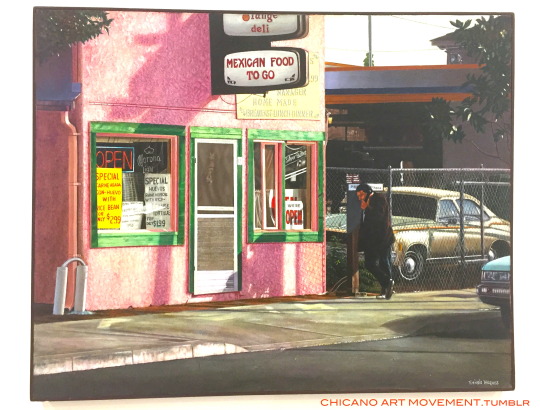
(Detailed view of Emigdio Vasquez’s piece from “My Barrio” exhibit at Chapman University.)
On a Saturday afternoon in December 2017, Robert and I traveled to survey the numerous components of “My Barrio: Emigdio Vasquez and Chicana/o Identity in Orange County” displayed at Chapman University, a small private liberal arts college located in Orange, California. Our first stop on campus was the Guggenheim Gallery that contained Vasquez’s original paintings that portrayed the daily activities of Chicanos and Chicanas living in Orange County. This gallery exhibit also had contemporary artists such as Ana Serrano and Shizu Saldmando amongst other participating artist.
The second portion of the Vasquez legacy was found outside the doors of the Guggenhiem Gallery. Within the Moulton Hall Courtyard of the university was a mural in progress by Higgy Vasquez, son to the celebrated Emigdio Vasquez. Higgy’s mural about the history of Chapman University once completed will also leave a mark within county’s narrative.
From the informational brochures provided by the institution, we walked over to the third location of the Argyros Forum Henley Galleria, within the student union, to learned more about the life of Emigdio himself through a timeline perspective. Through a historical lense, we saw family artifacts and heirlooms to examples of important events within Orange County that impacted Emigdio Vasquez’s development of consciousness which later expanded further during the Chicano Movement of the 1960s and beyond.
The last and fourth location of the “My Barrio” exhibition was located a few blocks away from the main campus in the Cypress Street barrio of the city of Orange. Emigdio Vasquez’s mural “El Proletariado de Aztlán” (1979) contained symbolism relating to different aspects of the Chicano/a history: from the Aztec warrior and their society’s pyramids to the brothers & sisters fighting for labor and civil rights for the current and future generation of la Raza. In addition, this mural was recently restored by Higgy Vasquez, son of the artist, in 2014 due to the funding provided by Chapman University. Overall, “My Barrio: Emigdio Vasquez and Chicana/o Identity in Orange County” was a collective experience that brought together the history of this county and the impact it had in the artwork by the late Emigdio Vasquez as well as those who continue to be inspired by his various murals found throughout Orange County, California.
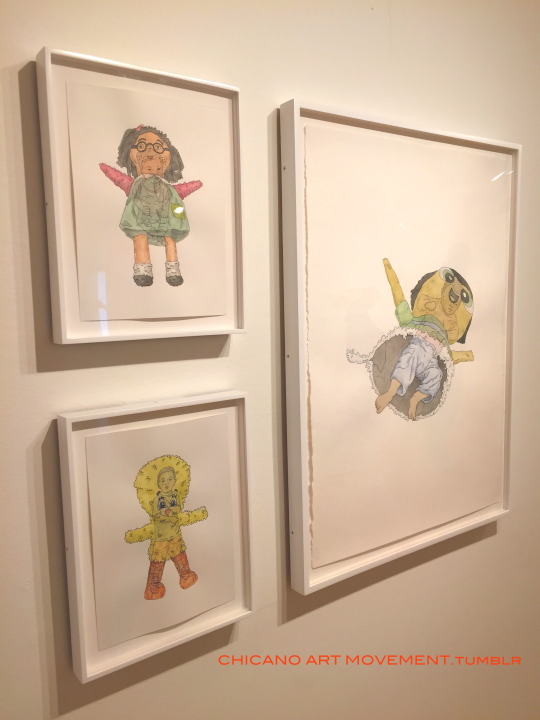
(Collection of “Undocumented Interventions” series by artist Julio César Morales at CAFAM.)
Our PST: LA/LA programming for December 2017 was “The U.S.-Mexico Border: Place of Imagination, and Possibility” at the Craft & Folk Art Museum (CAFAM) located in Los Angeles, California. The installations presented the “work of contemporary artists who explore[d] the border as a physical reality (place), as a subject (imagination), and as a site for production and solution (possibility).” This goal of exploration and explanation of border issues stayed true to its field: the analyzation of the unique relationship, history, and dynamics of the United States of America and Mexico border that expands across 1,954 miles and its impact on the millions of documented and undocumented people living on both sides of the border wall.
After taking in the introductory information, Robert and I began our journey through the various rooms and floors that manifested the impact of the border on the Chicano/Latino communities. We surveyed the works of various artists, such as Eduardo Sarabia and Betsabee Romero, who used reclaimed materials to demonstrated the power of globalization, commercialism, consumerism, and transnationalism.
On the first floor of CAFAM and adjacent to the introductory wall of exhibition title was the work by the Mexicana, Elizabeth Rustrian Ortega. The artwork entitled “Cruce de Armas” (2013) was a mixed medium piece in the form a fashionable women’s chunky necklace that consisted of synthetic materials shaped into smaller versions of fully automatic weapons in which a small female figure with no face sat atop of and was strung across a 14K gold-plated sterling silver barbed wire necklace. This distinctive necklace by Rustrian Ortega inspired me to think of this piece within the context of North American Free Trade Agreement (NAFTA) of 1994 and its effects of globalization and consumerism via the U.S.-Mexico border. Rustrian Ortega’s “Cruce de Armas” intentional shape of a necklace can also be interpreted to be the continuous and never-ending pattern of globalization and consumerism that produce amazing results for the people in power but come at a great cost to the people, their families, and communities.
After a small flight of stairs, we made to the third floor that contained part of the expansive exhibition “The U.S.-Mexico Border: Place of Imagination, and Possibility.” While taking in the artwork, I was surprised to see a statue of Chalino Sánchez, famous Mexican corrido singer, constructed out of cardboard and wood by artist Ana Serrano. Within the context of the exhibition, I connected Serrano’s manifestation of Chalino Sánchez in cardboard to the themes of commercialism and transnationalism. The subject matter of Chalino Sánchez (birth name: Rosalino Sánchez Felix) reflected his story as an immigrant from Sinaloa, México who during the during the late 1980s and early 1990s rose in popularity due to his unique interpretations of corridos y narcocorridos and his loyal fanbase who due to transnationalism knew and connected to the themes in his songs that included Mexican classics such as: “Nieves de enero,” “Tengo el alma enaorada,” y “Baraja de oro.” The use of cardboard as a medium by Ana Serrano can be connected to commercialism since cardboard boxes are used to move goods and items from one place to another; for example: from Mexico to the United States or del sur para el norte which can include music, personal items, family heirlooms, and cultural goods. To this day, commercialism and transnationalism keeps Chalino’s music alive since he was infused within the lives of Mexicanos, Mexican-Americans, Chicanos, and other Latinos who have heard, connected, and listened to his music for the past three decades.
We proceeded to the second floor and in a subsequent room, the works by Julio César Morales left a profound feeling due to my personal connection to the subject matter. “Undocumented Interventions #17, #1, and #16” illustrations depicted creative methods in which people, including children, risked their lives in order to cross the U.S.-México border through concealment. “Undocumented Interventions” showed the viewer how children and adults hid in everyday items to leave their native homeland in order to join the millions of people who work in U.S. to provide for their families. I connected to Morales’ series of works to my own family’s stories of migration through concealment and the greater risk that women and children/youth take to reach the United States in attempt to reach the “American Dream.” With his artwork, I took a moment of silence to remember my family trauma: stuffed into a car trunk with five unknown men and remain silent for countless hours; cross the U.S. border and the various checkpoints before reaching the final location; or, the desperation of wandering the Arizona desert for days while hiding from la migra to come back to one’s family after deportation.
In conclusion, this exhibition highlighted the truth, pain, resiliency, and tenacity of immigrants who cross through the U.S.-Mexico and all the communities who continue to work together to find solutions to border issues.

(Detail photo of Rafa Esparza’s ‘cumbre’ performance area at MOCA)
The final Pacific Standard Time: LA/LA event we attended landed us in January of the next calendar year, 2018, which also was towards the end of the overall PST: LA/LA event programming run. The showcase attended was Rafa Esparza’s performance of “cumbre” look as far as you can see in every direction - north and south, east and west” in Los Angeles, California at The Geffen Contemporary at MOCAgalleries.
We learned the basis of the performance would be that “this newly commissioned work by Rafa Esparza is an ambitious, three-part performance at The Geffen Contemporary at MOCA. Esparza’s point of departure is a meditation on bridges and bodies of water as sites of connection and healing, division and risk. The artist’s performance responds to personal, familial histories of immigration into the United States and the deeply complex history of downtown Los Angeles. Esparza will be joined by artist Sebastian Hernandez for a special collaboration in the final segment of the afternoon’s performance.”
Early arrival to the museum was necessary knowing there would be a line awaiting us to enter the venue. Once doors opened to the public, we were directed into the galleries transformed into am open concept performance area and guided over to a tall erected adobe edifice, part of which was a bridge the artist had laid under while performance goers crossed over to enter inside. Across from the bridge was a prominent sliver shiny wall which reflected opaque images of passers by.
With the audience situated Rafa slowly came from under the structure. Dressed in what appeared to be a burlap modesty cloth wrapped around the waist. Adorning the artist’s neck were long braids of hair that wrapped around like a necklace. The artist later uncoiled the braids which reached to the floor. Esparza then proceeded to dress himself. Brown pants, white sneakers and a red button up long sleeve shirt. Once fully clothed, Rafa then focused on a intermediate wooden structure that had a small stage with a frame built on to it, all located near the center of the gallery. Water was activated and poured from the top of the structure cascading on to the fully clothed artist. The creative let it be known with grunts and other unpleasant sounds that the water was not to temperature and overwhelming. All the while a super imposed image of a river scene was displayed on one end of the gallery walls through out the performance.
After the artist had come down from the wooden structure drenched, I noticed multiple puddles of water dyed red on the gallery floor due to Rafa’s shirt bleeding pigment. Esparza then made a path to a clear acrylic podium located off to the side that had a backdrop of living succulent plants and adobe bricks. That is where Rafa started the construction of his spoken word part of the performance. The speech focused on personal stories of family, migration and life in L.A. The artist even transcribed the challenging negotiations with the museum for the commission. Amidst the speech, artist Sebastian Hernandez walked in to the gallery on all fours in a primal fashion. Dressed in only brown linen pants and his head covered in one inch squared mirrors adhered to his scalp. Sebastian performed an interpretive dance utilizing all the space in gallery while Rafa concluded his address. In silence, Hernandez discarded his pants only to be left in underwear. A pair of clear acrylic heels were put on and the waterfall was once more activated. The virtuoso climbed up as the water came down. Then sounds of a hard hitting bass line started to pump through the space. The composition Sebastian Hernandez performed to was Kelman Duran’s “1984, Primero, Ultimo” as the water rained down. Once the production concluded the artist got down from the wooden structure and stopped the water. That is when Rafa Esparza and Sebastian Hernandez came together to exit through double doors for the grand exit.
Read our full write up on this event as: CHICANO ART MOVEMENT attends: Rafa Esparza: cumbre: look as far as you can see in every direction – north and south, east and west (2018)
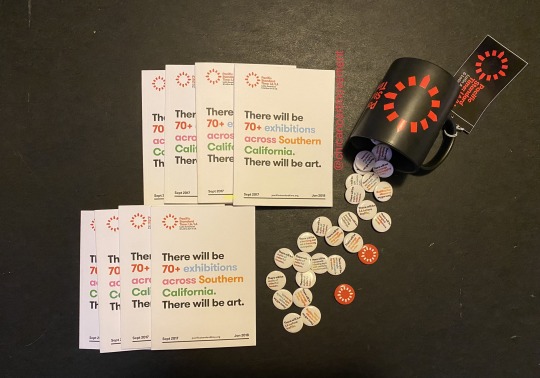
(Collection of PST: LA/LA branded items)
In conclusion, the programming of Pacific Standard Time: Latin American and Latino Art in Los Angeles 2017 was an extensive cross-cultural effort by the Getty Foundation alongside the collaboration of artists, galleries, institutions, and countless people who created art spaces that facilitated dialogues between Los Angeles and Latin America at a pivotal moment in time. CHICANO ART MOVEMENT and its staff provided media coverage and comments on the different aspects and facets of PST: LA/LA 2017. In total, CHICANO ART MOVEMENT attended 18 programming events, drove 704 miles across Southern California, networked with numerous artists and colleagues, read museum exhibition catalogues & supplemental materials to provide original and exclusive content during the run of PST: LA/LA from our independent outlet - the CHICANO ART MOVEMENT perspective. Through our coverage of Pacific Standard Time: Latin American and Latino Art in Los Angeles (2017) on CHICANO ART MOVEMENT’s various social media sites, we brought insightful commentary from the ground floor as an active audience participant of this grand artistic initiative.
CAM decided to become engaged with 2017′s Pacific Standard Time was due to: (1) the increased amount of Latin American art exhibitions and participants; (2) the immediate art availability to us in Southern California; (3) the engagement invitations from listed institutions and FINN Partners to see and live through the PST: LA/LA 2017 experience; and (4) our previous immersion with 2011’s Pacific Standard Time: Art in L.A. 1945 - 1980. CHICANO ART MOVEMENT focused time and effort to appreciate, take in, and to preserve the artwork, perspective, supporting information, and visions that brought each specific agenda to life and fruition. Overall, CHICANO ART MOVEMENT took each program as an opportunity to: (1) learn about Chicana/Chicano contributions within the arts here in Los Angeles; (2) be informed by Latin American art; and (3) most importantly, to digitally curate these artistic contributions to be viewed.
With the new year of 2017, we received an invitation to our first interaction of Pacific Standard Time and attended the PST: LA/LA Countdown Celebration at the NeueHollywood in January 2017. This launch party was filled with announcements, musical acts, and opportunities to mingle with different supporters of the arts. The night’s festivities reflected the growth from its previous entry of 2011 since the 2017 edition now contained more exhibitions, genres, mediums, and artists including musicians & performance artists, from both local and international levels.
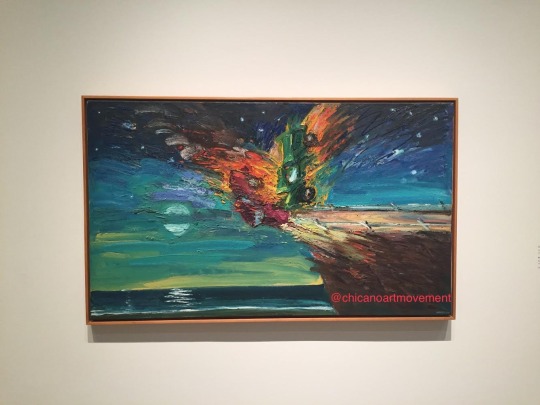
(Detailed view of “Over the Edge” an oil on canvas by Carlos Almaraz.)
Months later in August 2017 with the official launch of PST:LA/LA programming, CHICANO ART MOVEMENT reserved tickets for a late night press opportunity with Los Angeles County Museum of Art (LACMA)Muse ‘til Midnight event that drew inspiration from PST: LA/LA which transformed open museums spaces to include musical elements via DJ sets of various genres of the 1990s. The first exhibit titled “Home — So Different, So Appealing” contained different interpretations of the place of home with the added layer of migration. The listed artists provided a true reality of homes which led me to think of the concept of “staying in one place” can produce a sense of home and how countless Chicanas/Chicanos & Latin Americans are still working towards that goal. Moving to another area on the LACMA grounds, CAM staff saw the long awaited, life collection exhibition titled “Playing with Fire: Paintings by Carlos Almaraz.” Almaraz’s vibrant color usage provided clarity and beauty in his captivating car crashes and Echo Park scenes that enticed viewers to connect & get lost within the subject matter. The final exhibit on this LACMA trip was the exhibition “A Universal History of Infamy” with various participating artists. A specific piece that I gravitated towards was the installation by Vincent Ramos: an ephemeral collection of those “infamous” people in the Chicana and Chicano community. Ramos included books, magazines, pictures, tidbits, and historical information of infamous Raza members such as: Reies Lopez Tijerina, Freddy Fender, Ruben Salazar, and Lynda Carter. These three PST: LA/LA exhibits in conjunction with LACMA’s Muse ‘til Midnight provided a different vibe for patrons to enjoy the artwork with lively ambiance, promoted cultural expansion, and deconstructed the relationship between art institutions and its community members through a synchronization of art & music.
In the following month of September 2017, CHICANO ART MOVEMENT traveled to Muzeo Museum and Cultural Center in Anaheim to conduct a walk through of “Deconstructing Liberty: A Destiny Manifested.” Various Latin American artists shared their works and distinct interpretations of liberty as both a concept and a reality. In addition, the audience saw pieces that contained various themes of “post-liberty” such as: erasure, deletion, and insensitivity towards the people and their cultures of said Latin American countries.
In September 2017 and in conjunction with the Independence Day celebrations of various Latin American countries, the PST: LA/LA Concert was held at the historic Hollywood Bowl with the star studded lineup & in order of appearance: Mon Laferte (Chile), La Santa Cecilia (Los Angeles, CA), and Café Tacvba (México). From the concert, I most enjoyed that musical acts were included as an art form and that we had prime, front row seats to the whole performance during our first attending concert at the Hollywood Bowl.

(Concert lineup at the Hollywood Bowl, from left to right: Mon Laferte, La Santa Cecilia, and Café Tacvba.)
In October 2017, CAM returned to LACMA to survey another two entries of the PST: LA/LA itinerary. The first item of the day was “Found in Translation: Design in California and Mexico, 1915 - 1985” that created a visual, historical walkthrough of different examples of cultural exchange between the United States of America and Mexico. The focus was specifically the period between 1915 through 1985 in which over its 70 year span, each Mexico and the United States endured many transformations as countries with its peoples, respectively. From a historical point of view, the exhibit and accompanying catalogue shared accomplishments between the nations that highlighted artistic contributions and different interpretations within the four sectors of: Spanish Colonial Inspiration, Pre-Hispanic Revivals, Folk Art & Craft Traditions, and Modernism. Of all the items in this expansive exhibition, I gravitated towards the mid-century modern pieces as well as those related to Chicana and Chicano artists such as: Judithe Hernández, Yolanda M. Lopez, and David Botello. The last activity at LACMA for the day was an intimate tour of the Nuevo Museo de Arte Contemporáneo, or NuMu for short. This egg-shaped structure in a previous life actually sold eggs and, now in its current life, was transformed by Guatemalan artists Jessica Kairé and Stefan Benchoam into a traveling museum. The museum does grab one’s attention since it perpetuates that art can be containable, mobile, and connects with the audience on a micro level.
By late October 2017, CAM traveled to the Orange County shoreline of Laguna Beach, California to see three installments of PST: LA/LA. First, we saw saltfineart gallery’s exposition of “Descendants and Dissonance: Cultural Iconography in Contemporary Los Angeles” that featured Chicana/Chicano artists: Oscar Magallanes, Linda Vallejo, and Sonia Romero. Overall as an exhibit, Magallanes and Vallejo provided a critical point of view about the corporate imagery that is found in pop and personal cultures. In regards to the works by Sonia Romero, CAM was informed by gallery staff that her contributions were not viewable since the artist had already collected her pieces. After the art gallery, CAM walked a short distance to the Laguna Art Museum & its two entries in the PST 2017 programming. On the museum’s main floor, it housed the “California Mexicana: Missions to Murals, 1820 - 1930” exhibition containing paintings and artworks that provided a historical perspective of California as a Mexican territory to its growth as an incorporated state of the USA. On the Laguna Art Museum’s lower level, the works of “Dan McCleary: Prints from Oaxaca” provided an inside view to his thought & physical processes of printmaking working with copper plate etchings, techniques McClearly learned from Oaxaca.
In mid November 2017, CAM stepped onto the University of California, Irvine campus to view the “Aztlán to Magulandia: The Journey of Chicano Artist Gilbert ‘Magu’ Luján” retrospective organized by its University Art Galleries. This exhibition of the artist Gilbert “Magu” Luján reflected his interesting themes of love, mythic creatures, and migration. His vivid ceramic examples made one wonder about Luján’s academic graduate studies at UC Irvine during his MFA Sculpture program (1970 - 1973) and his pivotal role in organizing the first institutional exhibit of “Los Four: Almaraz/de la Rocha/Lujan/Romero” debuting at UC Irvine’s Art Gallery in 1973 before moving to LACMA in 1974.

(View of fine art print titled “Ford Enchilada being followed by un pan chicano” by Gilbert “Magu” Luján.)
The next of Pacific Standard Time programming took us to the eastern edge of Los Angeles County on a Saturday in late November 2017 to see a few entries. At the Claremont Colleges grounds, we traveled to the first location of the Pomona College Museum of Art to see the exhibit “Prometheus 2017: Four Artists from Mexico Revisit Orozco’’ (as of summer 2020, it is now known as the Benton Museum of Art at Pomona College). This programming of 4 artists – Isa Carrillo, Adela Goldbard, Rita Ponce de León, and Naomi Rincón-Gallardo – drew inspiration from the original Prometheus artwork by José Clemente Orozco (located in the college’s dining hall) and surrounded the viewer with contemporary examples, interpretations, and inspiration projected by the Orozco piece. Overall, Pomona College Museum of Art presented a very pleasing historical foundation with its permanent collection of how influential Orozco’s Prometheus fresco is on students and visitors as well as with artists. On the other side of the Claremont Colleges, we entered the Ruth Chandler Williamson Gallery at Scripps Collegefor“Revolution and Ritual: The Photographs of Sara Castrejón, Graciela Iturbide, and Tatiana Parcero.” All three artistas Mexicanas provided snapshots of the historical and contemporary impacts of Mexico on its people during a specific moment of time. As a photographer and digital curator, I connected to Castrejón, Iturbide, & Parcero and their usage of cameras, modern techniques, and subject matter since it conveyed the intimate thought behind the framed shot. Our last destination was away from the Claremont Colleges and five miles later, we were at the dA Center for the Arts located in Pomona’s Downtown. The dA Center’s PST: LA/LA exhibition was entitled “d’Aztlán: A Sense of Place” that included a collection of different Chicana & Chicano artists and their personal interpretations of Aztlán.
In early December 2017, CAM traveled to Chapman University to survey the Chicano muralist of Orange County, Emigdio Vasquez. The expansive endeavor of “My Barrio: Emigdio Vasquez and Chicana/o Identity in Orange County” was divided into four parts with three on campus locations & the other a few streets away, all properties belonging to the university. At the Guggenheim Gallery at Chapman, as a space it displayed Vasquez’s works that highlighted the urban perspective of Orange County barrios alongside other contemporary artists: Shizu Saldamando, Ana Serrano, and Ken Gonzales-Day. After exiting and directly across the gallery, we were in the Moulton Hall Courtyard and saw the new mural & its in-progress state. According to the accompany “My Barrio” exhibition map & guide: this “new mural […] will celebrate Chapman University’s history and identity” and “the mural is generously funded by the Ellingson family and is to be executed by Higgy Vasquez, who apprenticed under his father for many years, and is assisted by his sister, Rosemary Vasquez.” We then walked to the university’s Argyros Forum Henely Galleria area for Vasquez’s artistic outline of “critical events and movements of Mexican and Chicana/o history.” This included the agricultural aspect del barrio since Chicanas/Chicanos and Mexicanas/Mexicanos provided the needed human labor to work the orange groves that primarily covered the county between the 1940s through the 1960s. Away from campus and located within the community was the fourth Vasquez component, his “El Proletariado de Aztlán” mural that was originally painted in 1979 and was mostly restored by his son Higgy Vadquez in 2014. “El Proletariado de Aztlán” contained elements of the Chicana/Chicano consciousness and enlightenment since he displayed themes of huelga of political & agricultural topics, cultural resistance against Yankee assimilation & hegemony, and flourishing communities of color living in postwar America.
The day after Xmas 2017, we traveled back to Los Angeles’ Wilshire Boulevard to take in PST: LA/LA participating exhibition titled “The US-Mexico Border: Place, Immigration, and Possibility” at CAFAM (the Craft And Folk Art Museum was renamed to Craft Contemporary in 2019). The participating artists provided various examples of the hyper commercialization of goods, ideas, labor between the United States of America and Mexico. The various contributions in “The US-Mexico Border” exhibit illuminated the misconception of the American Dream and its unattainability by countless people on both sides of the USA/Mexico border since 1848 to the present day.
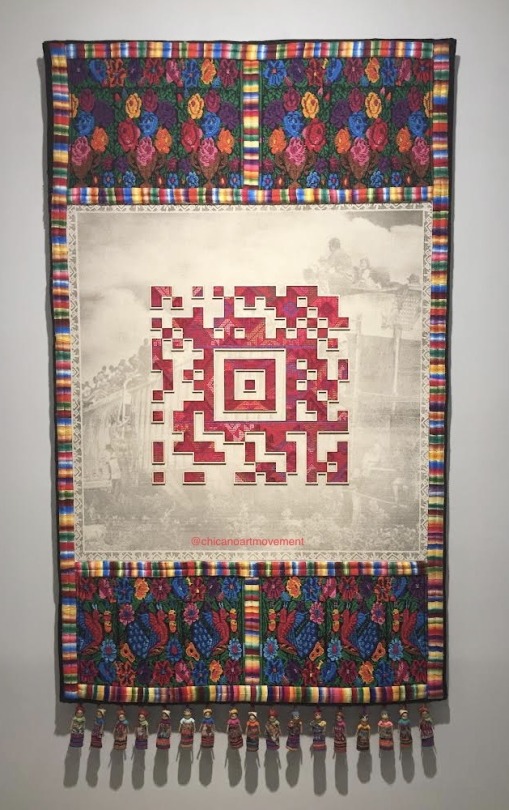
(Guillermo Bert [b. 1959, Santiago, Chile] and his 2016 cotton, woven textile piece titled “La Bestia/The Beast”)
A late entry within the PST: LA/LA programming came in mid-January 2018 with the performance artist of Rafa Esparza with “cumbre: look as far as you can see in every direction – north and south, east and west” at the Geffen Contemporary at MOCA, the Museum of Contemporary Art in Los Angeles, California. With tickets, we joined patrons for the performance of Rafa Esparza and special guest Sebastian Hernandez who engaged the audience from the moment one walked into the space. Through artistic expressions, they gave life to Esparza’s powerful written and spoken narration of life testimony that gave examples of inner dialogue when contesting boundaries.
To close, 2017’s Pacific Standard Time: Latin America and Latino Art in Los Angeles had lots to offer in the artworld. PST’s participating institutions and artists filled Southern California with meaningful art of different mediums which inspired, connected, and resonated with us. From my point of view, it was historic & empowering to see Chicanas and Chicanos being invited to contribute their artwork and have it hung on institutional walls but was the attending audience from the Chicana/Chicano community? There was a somewhat disconnection between the art and getting the audience to the artwork for illumination & resonation to occur. From personal recollection of what we attended, most venues only had a handful of attendees and I was left to ponder if PST 2017 met its numerical goal of people in attendance, particularly the number of people for whom this endeavour is named after.
Out of the list of CAM attended events, there were some highlights. My favorite was the PST: LA/LA Concert at the Hollywood Bowl since a great rockero band like Café Tacvba was the headliner and with our seating, lived the “front row life” & experienced their musical catalogue in a historical venue of Los Angeles. Robert gained the most knowledge from “Revolution and Ritual: The Photographs of Sara Castrejón, Graciela Iturbide, and Tatiana Parcero” at the Ruth Chandler Williamson Gallery of Scripps College. From attending and reading the accompanying catalogue, Robert learned a different perspective of Mexico as a nation including real life, gruesome historical details and events of the Mexican Revolutionary War. Of this exhibition and its participating female artists, Robert gravitated towards Graciela Iturbide’s famous surrealist works & was intrigued by Taitana Parcero’s contemporary twist of overlapping imagery on photographs.

(CAM’s catalogue collection of PST: LA/LA 2017 attended exhibitions.)
CAM would like to recognize and give thanks to those who provided support, materials, and information about PST: LA/LA which helped with our commitment in supplying commentary & curation of the Chicano Art Movement experience. Our appreciations go out to:
- Maura Klosterman-Vu, Senior Account Supervisor at Polskin Arts & Communications Counselors – A Division of FINN Partners
- Los Angeles County Museum of Art
- Laguna Art Museum
- The University Art Gallery and the Contemporary Arts Center Gallery at University of California, Irvine
- The Ruth Chandler William Gallery at Scripps College
Stay tuned here and our other social media sites for the final installation of a three part series by CHICANO ART MOVEMENT blog’s coverage of the review of PST: LA/LA Attended Programming.
Oswaldo Guayasamín (Ecuadorian, 1919-1999), Los desesperados,1970. Oil on canvas, 160 x 109.5 cm
Post link


